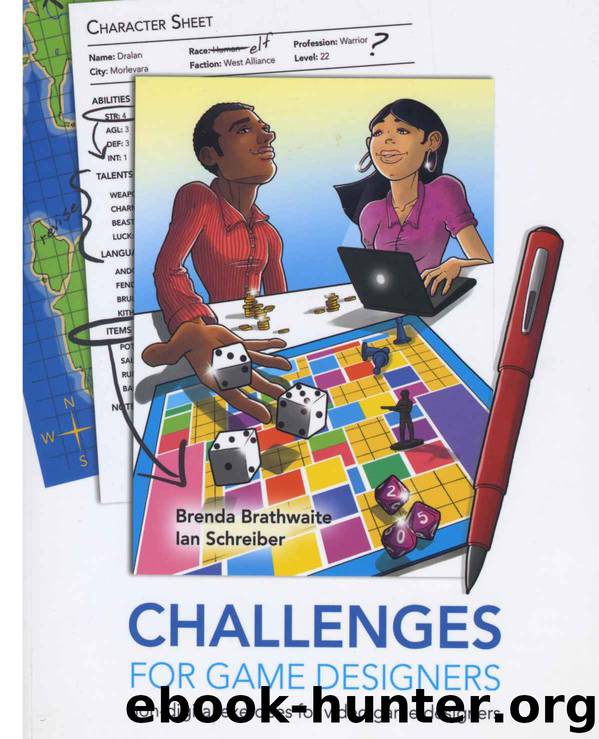Challenges for Games Designers: Non-Digital Exercises for Video Game Designers by Brenda Brathwaite & Ian Schreiber

Author:Brenda Brathwaite & Ian Schreiber [Brathwaite, Brenda]
Language: eng
Format: azw3
Publisher: UNKNOWN
Published: 2017-01-23T05:00:00+00:00
12: Learning an Unfamiliar Genre
Most of the time, a publisher approaches a developer with a request for a proposal (RFP) with a specific genre in mind. “Give us an MMO targeted at kids,” they’ll say. “That market’s growing more every year.”
In a way, this is somewhere between making a sequel and targeting a market. You are, technically, targeting the market of people who like games of a particular genre, and it’s expected that the game will conform to that genre in the same (if less restrictive) way that a sequel will conform to its predecessors.
If you’ve designed dozens of RPGs and played hundreds more, and you’re asked to create an RPG, this is not a problem. If you’re asked to create a social simulation or a sports game, and you’ve never designed one, then you’d better find a way to learn... and fast.
WHY START WITH GENRE?
Publishers often request a specific genre. Genres, like markets, are easy to track; the industry keeps numbers on how well genres are doing (in terms of how many different games are produced, and how many purchased, each year). Publishers can detect certain market trends by genre that signal a financial opportunity. For example, if they know that there are 25 million RPG players in the world and that no other RPGs have been announced for Q4 of next year on the leading console, they might decide to finance one on the theory that fans of the genre will buy anything if it’s their only choice. Such opportunities are what allow games like Summoner to be highly profitable, in spite of mediocre review scores (and, to be fair, games like Baldur’s Gate: Dark Alliance, which have outstanding review scores, but might have done less in sales if they didn’t also have a monopoly on their genre for at least six months in either direction).
HOW TO START
Learning a new genre well enough to design a game in it is among the most difficult things a designer can be asked to do. The basic principles of research are present here in all their glory, but the research is more demanding than usual if you want to honor the player.
PLAY, PLAY, PLAY
If you’re new to the genre you’re designing in, immerse yourself within the genre’s world. Play every game you can get your hands on, paying particular attention to the latest games in the genre. Play first as a player, trying to find the fun. If it’s not fun for you, at least try to figure out why it might be fun for enough other people to support the genre (but seriously consider whether you’re the right designer for the job). After playing as a player, play as a designer, figuring out what mechanics create the fun. It is easy to say “we should include feature X because well-known Game Y has it” and equally easy to say “we shouldn’t include feature X in order to differentiate our game from well-known Game Y”; knowing when to say each is critical.
Download
This site does not store any files on its server. We only index and link to content provided by other sites. Please contact the content providers to delete copyright contents if any and email us, we'll remove relevant links or contents immediately.
Blood, Sweat, and Pixels by Jason Schreier(3566)
Godot 4 Game Development Cookbook by Jeff Johnson(2862)
Dawn of the New Everything by Jaron Lanier(2738)
The Art of Doom by Bethesda(2108)
Significant Zero by Walt Williams(1929)
Creative Character Design by Bryan Tillman(1889)
Art Of Atari by Tim Lapetino(1750)
World of Warcraft Chronicle Volume 3 by Blizzard Entertainment(1707)
The Ultimate Roblox Book by David Jagneaux(1657)
Mission Python by Sean McManus(1655)
Pillars of Eternity Guidebook by Obsidian Entertainment(1626)
Dawn of the New Everything: Encounters with Reality and Virtual Reality by Jaron Lanier(1578)
Unreal Engine 4 Virtual Reality Projects by Kevin Mack(1527)
1628927445Game by Unknown(1524)
Unreal Engine Virtual Reality Quick Start Guide by Jessica Plowman(1513)
Learning D by 2015(1490)
The Ultimate Player's Guide to Minecraft by Stephen O'Brien(1489)
Unity 2018 By Example by Alan Thorn(1430)
Road Games by Road Games(1416)
